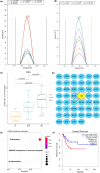Identification of COPA as a potential prognostic biomarker and pharmacological intervention target of cervical cancer by quantitative proteomics and experimental verification
- PMID: 34991628
- PMCID: PMC8740354
- DOI: 10.1186/s12967-021-03218-1
Identification of COPA as a potential prognostic biomarker and pharmacological intervention target of cervical cancer by quantitative proteomics and experimental verification
Abstract
Background: Cervical cancer is the most fatal gynecological carcinoma in the world. It is urgent to explore novel prognostic biomarkers and intervention targets for cervical cancer.
Methods: Through integrated quantitative proteomic strategy, we investigated the protein expression profiles of cervical cancer; 28 fresh frozen tissue samples (11 adenocarcinoma (AC), 12 squamous cell carcinoma (SCC) and 5 normal cervixes (HC)) were included in discover cohort; 45 fresh frozen tissue samples (19 AC, 18 SCC and 8 HC) were included in verification cohort; 140 paraffin-embedded tissues samples of cervical cancer (85 AC and 55 SCC) were used for immunohistochemical evaluation (IHC) of coatomer protein subunit alpha (COPA) as a prognostic biomarker for cervical cancer; how deficiency of COPA affects cell viability and tumorigenic ability of cervical cancer cells (SiHa cells and HeLa cells) were evaluated by cell counting kit-8 and clone formation in vitro.
Results: We identified COPA is a potential prognostic biomarker for cervical cancer in quantitative proteomics analysis. By retrospective IHC analysis, we additionally verified the proteomics results and demonstrated moderate or strong IHC staining for COPA is an unfavourable independent prognostic factor for cervical cancer. We also identified COPA is a potential pharmacological intervention target of cervical cancer by a series of in vitro experiments.
Conclusion: This study is the first to demonstrate that COPA may contribute to progression of cervical cancer. It can serve as a potential prognostic biomarker and promising intervention target for cervical cancer.
Keywords: Cervical cancer; Coatomer protein subunit alpha; Immunohistochemistry; Proteomics; Tumor mechanism.
© 2022. The Author(s).
Conflict of interest statement
The authors declare no conflict of interest.
Figures








References
-
- Ahmad A, Ansari IA. A Comprehensive Review on Crosstalk of Human Papilloma Virus oncoproteins and developmental/self-renewal pathways during the pathogenesis of uterine cervical cancer. Curr Mol Med. 2020;89:234. - PubMed
-
- Lu X, Wang Z, Zhang S, Konijnenberg AP, Ouyang Y, Zhao C, Cai Y. Microscopic phase reconstruction of cervical exfoliated cell under partially coherent illumination. J Biophotonics. 2021;14:e202000401. - PubMed
-
- Zorzi M, Mistro A, Farruggio A, Bartolomeis L, Frayle-Salamanca H, Baboci L, Bertazzo A, Cocco P, Fedato C, Gennaro M, et al. Use of a high-risk human papillomavirus DNA test as the primary test in a cervical cancer screening programme: a population-based cohort study. BJOG. 2013;120:1260–1267. doi: 10.1111/1471-0528.12272. - DOI - PubMed
-
- Han R, Shi Q, Wu S, Yin D, Peng M, Dong D, Zheng Y, Guo Y, Zhang R, Hu F. Dissemination of Carbapenemases (KPC, NDM, OXA-48, IMP, and VIM) Among Carbapenem-Resistant Enterobacteriaceae Isolated From Adult and Children Patients in China. Front Cell Infect Microbiol. 2020;10:314. doi: 10.3389/fcimb.2020.00314. - DOI - PMC - PubMed

